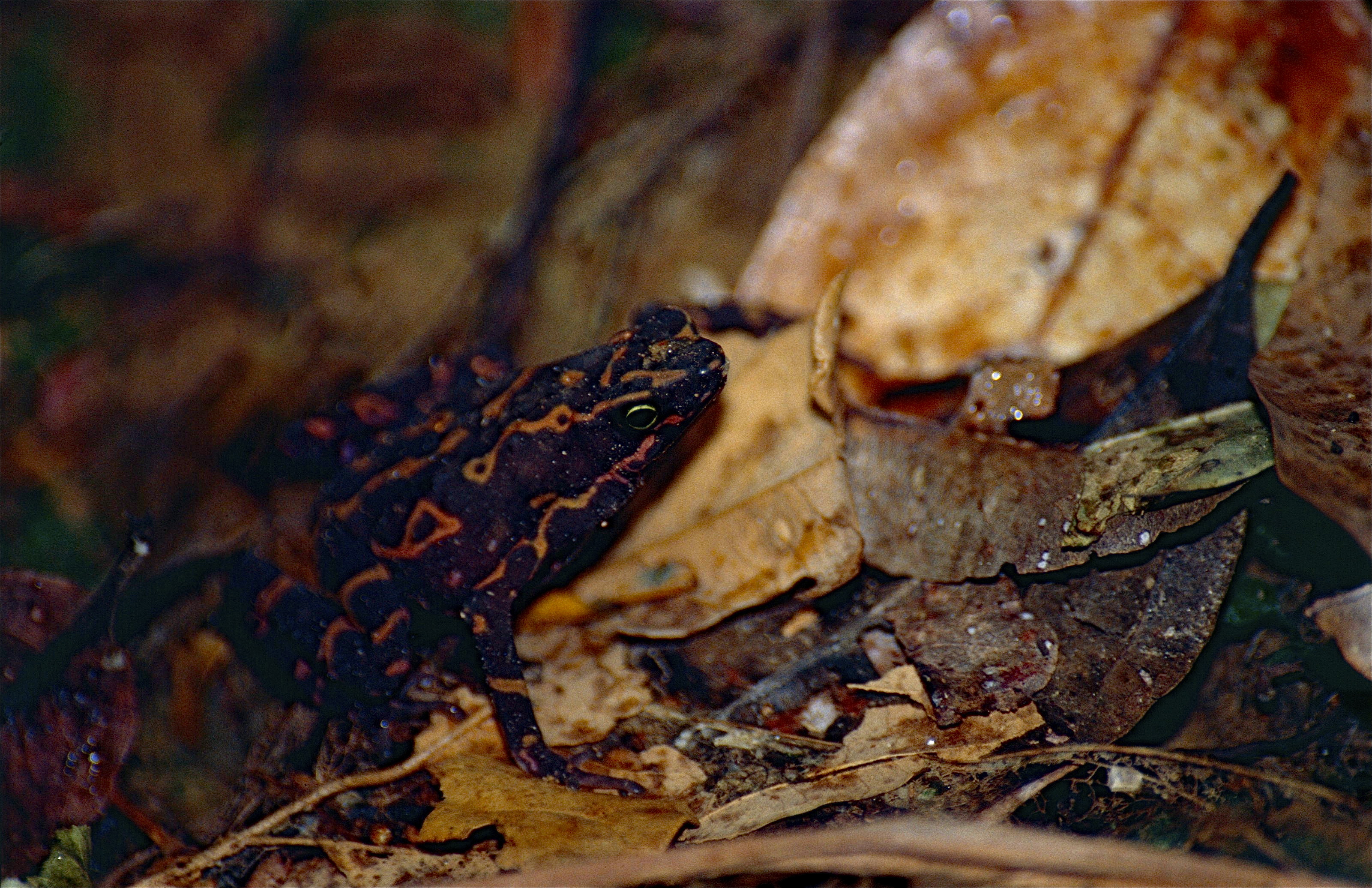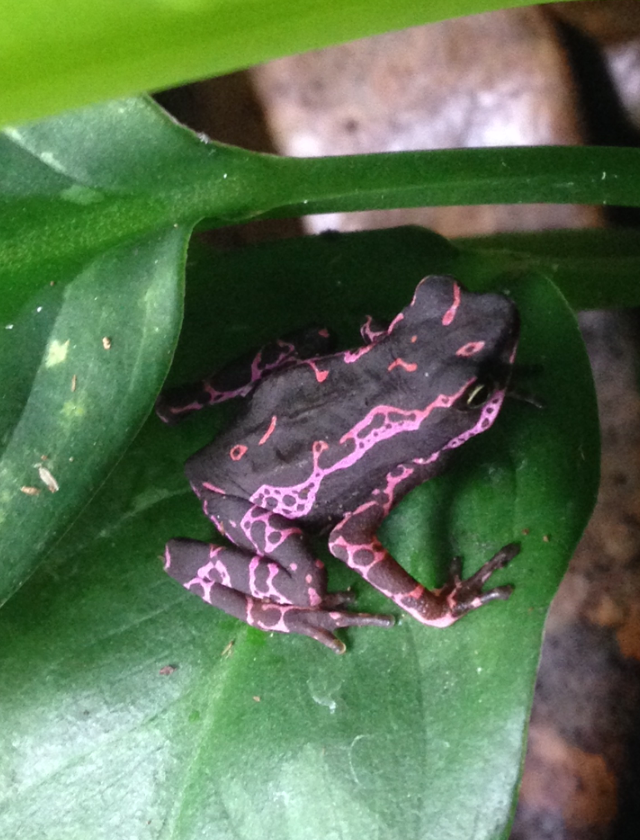- Atelopus barbotini: The Vibrant Jewel of South America's Fragile Rainforests
- Taxonomy and Classification of Atelopus barbotini
- The Natural Habitat and Distribution of Atelopus barbotini
- Physical Characteristics and Remarkable Adaptations
- Secretive Behavior and Remarkable Life Cycle
- Atelopus barbotini's Ecological Role
- Conservation Challenges and the Road Ahead
- Cultural and Scientific Insights from Atelopus barbotini
- A Call to Protect the Fragile Gem of our Forests
Atelopus barbotini: The Vibrant Jewel of South America’s Fragile Rainforests#
Hidden beneath the lush, dense canopy of South America’s thriving rainforests lives a striking marvel—a tiny amphibian known as Atelopus barbotini. Commonly referred to as the purple fluorescent frog, this colorful species captivates anyone who glimpses its vivid appearance. As a member of the iconic Atelopus genus, known for their brilliant coloration and alarmingly rapid decline in population globally, this diminutive frog embodies the delicate beauty of the ecosystems it inhabits and the relentless challenges they face. A beacon of biodiversity often overshadowed by larger, flashier wildlife, the Atelopus barbotini is an ecological treasure, quietly thriving or struggling amidst whispering trees and hidden streams.
Remarkably, this tiny, bold-colored amphibian carries within it not just aesthetic allure, but also potent biochemical secrets that scientists continuously unravel. Far more than a beautiful rainforest inhabitant, it provides key insights into environmental health, amphibian survival, and broader conservation messages urgently needing our attention.
Taxonomy and Classification of Atelopus barbotini#
Delving to the taxonomic roots of Atelopus barbotini reveals an amphibian intricately connected to the diverse tapestry of South American biodiversity. Belonging to the family Bufonidae—commonly known as true toads—Atelopus barbotini illustrates the vast morphological and behavioral diversity within this expansive family. Unlike the stereotypical rough-skinned, drab-colored toads familiar from temperate regions, the Bufonidae mining the lushness of South America’s rainforests typically exhibit vividly colored skins, smooth textures, and secretive, nocturnal lifestyles.
Within this family resides the genus Atelopus, known universally among herpetologists and conservationists for three distinctive attributes: striking colors, limited geographical distributions, and severe population threats linked to habitat loss, climate shifts, and disease. Atelopus barbotini belongs within this context, closely related to species like Atelopus flavescens and Atelopus franciscus. Described initially by Lescure in 1981, Atelopus barbotini remains somewhat elusive, and researchers’ understanding evolves with each painstaking field study or exciting new finding.
The Natural Habitat and Distribution of Atelopus barbotini#
Journey into northern South America—specifically French Guiana—and you step beneath an emerald canopy laden with moisture, cloud-wreathed mountain ridges, and intertwined tree roots creating dense, damp retreats. This is the realm of Atelopus barbotini. Indigenous to a remarkably small, ecologically specific region of lowland and submontane rainforests, Atelopus barbotini is found flourishing quietly around small to medium-sized stream systems, their gently flowing waters carving winding channels through soft rainforest soil.
Preferring humid, undisturbed forest patches, this species thrives where temperatures remain consistent—from 18 to 26°C—and humidity lingers perpetually high. Leaf litter, moss-covered rocks, and stems edging pristine shaded streams offer protection, sustenance, and breeding grounds for these sensitive creatures. The complexity and specificity of their microhabitat emphasize the delicate balance Atelopus barbotini needs, demonstrating the significant impact any changes to local geography or climate possess.
Within this carefully constructed ecosystem, the frog’s existence is perfectly synchronized with its environment. Rainforest cover provides adequate moisture and thermal stability, and clear, oxygen-rich waters foster successful breeding and larval development. In turn, Atelopus barbotini completes a critical chapter in a vibrant ecological story, linking forest and freshwater realms tightly together.
Physical Characteristics and Remarkable Adaptations#
At first glance, Atelopus barbotini appears as if crafted by a whimsical artist. Measuring only around 2-4 centimeters, they embody striking beauty in a compact stature. Most notably, their coloration is both vibrant and playful—typically shades of brilliant purple or vivid violet, interspersed with contrasting patches of black or darker purple lines, spots, or mottling patterns. To observers, the unusual pigmentation serves almost as a painter’s confident affirmation that nature itself wields unmatched imagination.
The bright skin pigmentation is more than aesthetic bravado: it signals a stark warning to potential predators. Atelopus barbotini, like many brightly-colored amphibians, possesses skin glands capable of secreting toxins. While further research continues, scientists theorize these secretions deter common predators such as birds, snakes, and small mammals, safeguarding these small amphibians from predation and ensuring their continued presence within precarious rainforest ecosystems.
Their smooth, agile limbs further enable precise movements, necessary for navigating moss-covered terrain and slippery, wet surfaces of creek banks. Notably elongated hind limbs grant swift, controlled leaps to evade threats, while webbed feet facilitate efficient swimming in flowing streambeds. Uniquely adapted tactile sensors along digits detect subtle environmental cues, significantly aiding in hunting small arthropod prey, for instance, insects crawling stealthily on rainforest substrates.
Secretive Behavior and Remarkable Life Cycle#
Feeding and Hunting Strategies#
As opportunistic insectivores, Atelopus barbotini engages in precise, calculated predation on tiny arthropods scuttling along surfaces of plants, moss, and soil. Their hunting tactics depend heavily upon subtle observation, patience, and decisive ambush. Equipped with exceptional eyesight and sensitive skin receptors, these frogs strategically position themselves, blending invisibly within the purple-hued backgrounds of their habitat shades, before launching swift, accurate strikes that reliably deliver prey into their mouths.
Reproduction and Parental Behavior#
Every year, as streams swell with seasonal rains, Atelopus barbotini initiates its breeding season. Males produce soft, rhythmic calling sequences along banks and among sheltered plants emerging from shallow waters. These resonant calls, often compared by researchers to gentle, rhythmic clicking, signal availability and fitness to receptive females.
Upon mating, the female attaches gelatinous egg clusters beneath submerged rocks or leaves of aquatic plants. Each egg clutch contains hundreds of translucent eggs, carefully positioned to remain safe from predatory fish or birds. Tadpole development proceeds rapidly, relying solely on nutrient-rich yolk until metamorphosis completes, producing miniature replicas of adult frogs fully prepared for terrestrial life.
Unlike some amphibians boasting elaborate parental care, Atelopus barbotini displays limited direct parental involvement. However, the precise choice of egg-laying sites demonstrates deliberate efforts to maximize offspring survival, indicating a subtle yet critical form of parental care embedded deeply into their reproductive strategy.
Atelopus barbotini’s Ecological Role#
Beneath their visually appealing exterior and intriguing behavior lies an essential ecological niche occupied by Atelopus barbotini. As competent hunters of insects, they significantly help maintain arthropod populations balanced within rainforest ecosystems, contributing indirectly to plant health and soil quality. Equally meaningful is their role as prey; despite chemical defenses, populations face natural predation pressure, thus becoming valuable food resources for specialized rainforest predators such as weather-resistant snakes or certain insectivorous mammals adeptly circumventing toxins through evolved resistance mechanisms.
Additionally, Atelopus barbotini serves as a sentinel species—amphibians often represent early indicators of ecological change or stress, notably pollution, deforestation, or emerging disease outbreaks. Their presence or health in stream systems can swiftly indicate shifting environmental conditions, providing crucial warnings to ecologists or conservationists in pursuit of accurate ecological assessments.
Conservation Challenges and the Road Ahead#
While Federally protected within French Guiana, Atelopus barbotini faces significant threats requiring vigilant conservation attention. Habitat loss remains paramount—driven by logging, illegal gold mining operations that alter stream habitats, and agricultural expansion encroaching into pristine rainforest ecosystems. These pressures have significantly fragmented once contiguous populations, complicating breeding and successful gene flow among fragmented populations.
An alarming global amphibian crisis, exacerbated by fungal pathogens such as chytrid fungus (Batrachochytrium dendrobatidis), also looms ominously over their fates. Thankfully, Atelopus barbotini’s wild populations thus far appear minimally impacted by chytridiomycosis; however, continual monitoring remains urgently necessary to identify potential outbreaks before they spread uncontrollably.
Currently assessed by the International Union for Conservation of Nature (IUCN) as “Data Deficient,” significant gaps in population data, conservation biology interventions, and habitat protection efforts require immediate attention. Researchers advocate for comprehensive habitat protection, strengthened enforcement against illegal activities, and broader ecosystem-centric conservation strategies aimed at sustaining viable long-term populations.
Cultural and Scientific Insights from Atelopus barbotini#
While cultural narratives surrounding Atelopus barbotini remain scarce compared to more prominent species, indigenous communities recognize its symbolic tie to forest health and balance. Scientifically, examining toxins, behavior, and adaptability furthers our deeper understanding of biodiversity resilience amid accelerating ecological changes, reinforcing broader global lessons about protecting fragile habitats.
A Call to Protect the Fragile Gem of our Forests#
Atelopus barbotini exemplifies the profound interconnectedness of biodiversity, underlining the undeniable link between species and the ecosystems sustaining us all. Conserving their habitats, acknowledging their ecological significance, and ceaselessly educating ourselves prove imperative—lest we risk losing this vibrant ambassador of thriving rainforest life. Let Atelopus barbotini remind us that even the smallest beings possess immense ecological value.










